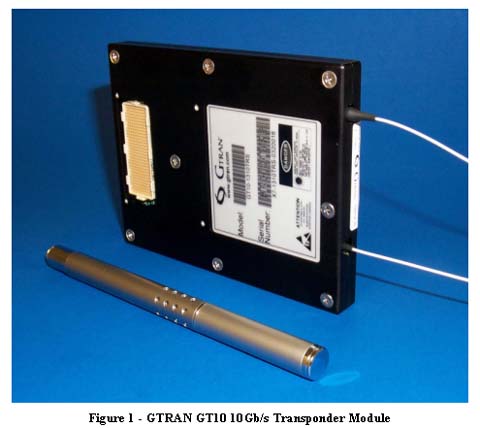Have You Heard the One About the Elephant and the Mouse ?

by Mark Darrow
Director of Fiber Optic Sales
GTRAN
Regardless of which fable, metaphor or joke you've heard, the size relationship between the elephant and the mouse has stood the test of time. And the OC-192 transponder module market is no exception.
 As the optical networking equipment market continues to segment and stratify, opportunities continue to abound for both start-ups and giants alike. "Eight hundred pound gorillas" such as Lucent, Alcatel, Sumitomo, Hitachi and Nortel have set up various multi-sourcing agreements (MSA) intended to establish standard performance features, mechanical outlines and interconnects.
As the optical networking equipment market continues to segment and stratify, opportunities continue to abound for both start-ups and giants alike. "Eight hundred pound gorillas" such as Lucent, Alcatel, Sumitomo, Hitachi and Nortel have set up various multi-sourcing agreements (MSA) intended to establish standard performance features, mechanical outlines and interconnects.
But the MSA building process has also created growth opportunities for creative pre-IPO newcomers like GTRAN Incorporated. GTRAN introduced the industry's first fully integrated, self-contained 10 Gb/s transponder (Figure 1), and now continues to challenge the marketplace with a whole family of MSA-compatible 10G transponders and "simplex" receivers and transmitters.

What is the winning formula for success in the rapidly evolving 10Gb/s transponder market? Currently, near term solutions appear to be SONET/SDH OC-192 modules, built around a 300 pin electrical connector …with less obvious answers in 2002.
Today's customer (reluctantly) leans toward solutions that combine cost-effective, flexible, readily available SONET transponders, allowing them to be first-to-market. Almost everyone understands that our current SONET-dominated world is not going to disappear soon, so this ubiquitous protocol is "handy", but not the most cost-effective or permanent answer.
Secondly, in-house customer solutions are achievable, but difficult to manage due to the allocation of strategic components. Optics (lasers and PIN-based receivers) lead times are crawling out to 18-20 weeks. Laser pricing (especially 1550's) is "market based", which translates to "whatever the market can bear". And even analog IC's, tantalum ceramics and crystals (XO & VCXO) have achieved rarefied lead times approaching 26 weeks. Even in the most rigorous of manufacturing environments, OC-192 transponder boards are inconsistent in their unit-to-unit performance (following assembly and final test).
Finally, a 10G transponder module needs to serve today's time sensitive applications, and quickly clone itself into several cost-effective, application-specific solutions in the months and years to come. GTRAN's next generation 10G transponders will focus on very specific reaches, and the module price will be directly related to the application, and the associated optics and IC's available in the marketplace.
GTRAN's in-house optics and high speed IC design and development capabilities will play a key role in driving performance / cost trade-offs in the year 2002 and beyond. Less expensive receivers, uncooled lasers and low cost IC's will put GTRAN at the forefront of high-speed O-E-O data transceivers.
On the surface, it may appear that designing 10G transponder boards would be relatively simple. On the other hand, GR-1377, OIF, SONET/SDH and 10GbE compliance can be very difficult unless close attention is paid to sub-assembly integration and component selection / definition.
In order to meet this demand, GTRAN has developed a family of 10G products that can meet a broad range of customer requirements. The baseline GT10-1310TRS and GT10-1550TRS transponders have enough built-in design flexibility to accommodate both negatively and positively biased lasers, two brands of SERDES chips, two different types of laser drivers and various reference clocking schemes.
GTRAN transponders modules are fully compliant with GR-253-CORE SR-1/2, IR-1/2, are 10Gb Ethernet ready and meet OIF99.102.8 SERDES timing requirements. With a typical receiver sensitivity of –17 dBm, phase nulling for improved jitter performance and a broad operating temperature range; GTRAN's MSA-compatible10G transponder modules are ideal for intra-office, point-to-point and interoperability applications.
The GT10-1310 (or 1550) TRS module is an integrated high speed data transponder optimized for OC-192/STM-64 applications, and can handle data rates up to 10.7 Gb/s. The direct modulated laser module and a PIN-detector-based optical receiver module convert data streams between the electrical and optical domains.
A high performance laser driver and receiver amplifiers are incorporated to provide optimum signal levels throughout the assembly. A 16:1 MUX and a 1:16 DEMUX translate the OC-192/STM-64 data rate to multiple signals at STS-12/STM-4 rate, with LVDS interface for convenient integration with lower bit rate VLSI chips.
Low noise clock/data recovery and clock multiplication electronics based on phase-locked loops yield full SONET compliance for jitter generation, jitter transfer and jitter tolerance. MSA-compatible status and alarm signals are available to allow monitoring of key operating parameters.
The GTRAN GT10 module is manufactured in a compact 4.5"x3.5"x0.53" assembly with integrated heat sink, and low profile heat transfer topside "mesa" structure (allowing omni-directional orientation in the rack-mounted equipment). All sensitive active components are hermetically sealed.
The module runs on a triple (+5V, +3.3V, -5.2V) voltage supply, and typically consumes 8.5W at room temperature and 10W maximum. All electrical signals are interfaced via a single low profile connector, while the optical signals are provided via fiber pigtails, with customer specified connectors.
GTRAN continues to develop new 10Gb/s sub-assembly solutions, and has developed 1550nm single frequency transponders, DWDM versions and "simplex" receivers and transmitters, also utilizing the same low profile electrical connectors as current MSA versions.
About the Author
Mark Darrow, GTRAN's Director of Optical Sales and Marketing, has 16 years of sales management and business development experience with high-technology companies. He was previously the Vice President and Area Director with AVNET, Inc. Prior to AVNET, he was the District Manager of the Southern California regions with M/A-COM, Inc. Darrow holds a Bachelor of Science in Engineering from the United States Naval Academy.
About GTRAN
GTRAN Incorporated is a leading provider of fiber optic subsystems, enabling rapid deployment of the fastest optical technologies by offering integrated product solutions that allow easy implementation of it's customer's systems. GTRAN is focused on the application of digital fiber optics to provide a broad line of high-performance, reliable, value-added optical subsystems for networking equipment manufacturers.
GTRAN's operations are located at 5701 Lindero Canyon Road, Suite 1-204, Westlake Village, CA 91362. For more information, visit GTRAN's Web site at http://www.gtran.com.
